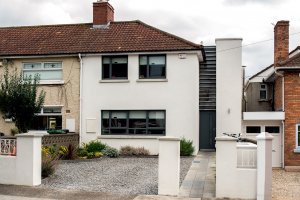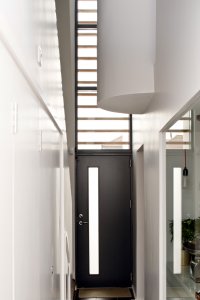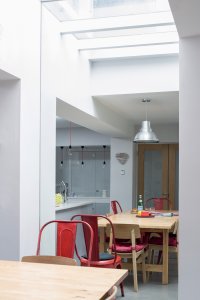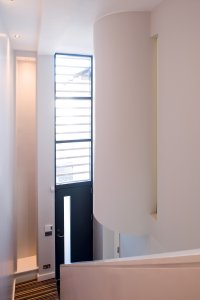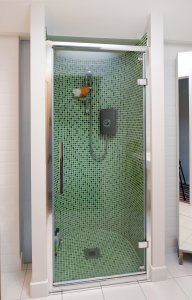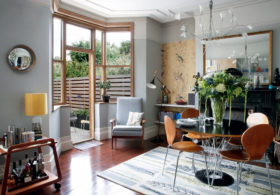Contemporary Renovation and Extension to a Terraced Home
After five years searching for the perfect renovation opportunity, Don and Ruth Boardman purchased their three-bedroom, end-of-terrace house in Dublin in 2012.
Despite the dated 1970s interiors, the couple envisioned how to improve the dwelling – by adding a two-storey side and rear extension to create an open-plan living area on the ground floor.
The pair share the home with their three children Rebekah, Naomi and Levi, plus Mylo the bichon frise. As a family therapist, Don has a strong appreciation for how a well-designed property can enhance day-to-day life for the entire household. “I believe the right living space can enable people to connect with each other in the best possible way,” he says.
“Fritz Redl, the child psychologist, said ‘A house that smiles, props that invite, space which allows,’ and that rings so true for us. This is what we wanted, and we succeeded thanks to architect, Dave Egan.”
Hiring an architect
The terrace was built 90 years ago for British military officers and their families who settled in the area. “Little by little, these homes came up for sale,” says Don. “Ruth and I are big fans of Modernist architecture, and we hoped to create a contemporary design with large spans of glazing to connect the house to the outdoors.”
- NamesDon & Ruth Boardman
- LocationDublin, Ireland
- Type of projectExtension & renovation
- StyleContemporary
- Construction methodTimber frame with brick walls
- House size140m²
- Project cost€210,000
- Cost per m² €1,500
- Construction time32 weeks
- Current value€650,000
One designer the couple have always admired is Irish architect Eileen Gray. By chance, the early phases of their project coincided with an exhibition of Gray’s work at the Irish Museum of Modern Art.
“This ended up having a huge influence on our project – particularly the flat-roof, white-box style of the house. I must have visited the event 18 times for inspiration,” says Don. “Our humble scheme seemed to absorb much of Gray’s vision by osmosis.”
The next step for the Boardmans was to find a designer to help them take the project forward. Dave Egan from Node Architecture was put forward by Ruth’s sister-in-law, Rachel.
“We met with lots of people, but within five minutes of meeting Dave, we knew he was the right man for us,” says Don. “He has so much imagination. He saw us through the planning stage and every element of the process thereafter. If we were to ever get the chance to work with him again in the future, I would do it in a heartbeat.”
The brief was to extend the house to create an open-plan kitchen, dining and living area featuring large internal glazed panels to reflect both light and space. The couple also wanted concealed utilities and a new WC within a ground floor area that would be almost double the size of the original footprint.
“We’d done a renovation before, but we’ve never had a chance to plan the layout of our home completely,” says Don. “Rachel has a great sense of style and design, and she really helped us through the project in terms of visualising the space.”
Dave, Ruth and Don developed the concept for a white-box side and rear-extension featuring large aluminium-clad windows, plus hardwood louvres to infuse the property with extra visual allure. Creating a highly airtight structure was also at the top of the couple’s priority list, so they added insulation to cut down heat loss.
After the pair’s application sailed through planning successfully, they selected local firm Wardell Brothers to handle the construction side of the scheme. Rather than contend with the stress of living onsite during the works, they opted to rent a nearby house so that they’d be able to keep a close eye on the build’s progress.
Build progress
Once the contractors started work, Don and Ruth’s new-look home began to take shape quickly. “This was our most challenging renovation endeavour by far,” says Don. “Some nights we’d struggle to sleep as our minds raced with the logistics, but the satisfaction of seeing it all come together made the stress worth it.”
The only structural setback arose when a sewer pipe collapsed beneath the property’s new underfloor heating system. This was an unforeseen expense for Don and Ruth, and one that added delays to the build schedule. However, the hiccup didn’t hold up progress too much and the addition of the internal glazed panels and sliding glass doors marked positive milestones in the project.
One of Don’s favourite features is the newly-remodelled entrance hall. Architect Dave found a clever way to incorporate the property’s existing gable wall into the extension, by cutting two holes in it and securing a new brick outer wall 1.5m away. An atrium-style double-height stairwell was constructed in the gap. “It’s spectacular. I make a point of walking up the stairs slowly so I can really enjoy it,” says Don.
Other ground floor revisions include the new open-plan space with separate zones for cooking, dining and relaxing. Eye-catching features include a mirrored partition in the kitchen-diner and a glazed screen instead of a solid wall in the kitchen.
The other side of this level now houses a WC, boot room and utility area, with an unusual feature. “When Dave first suggested a laundry chute, I was a little dubious, thinking that he’d perhaps watched a few too many American movies,” says Don. “But this clever addition resulted in a significantly decreased workload when it comes to washing clothes.”
The property’s main bathroom is another one of the Boardmans’ favourite elements, as the shower cubicle is positioned within the suspended half-cylinder structure that projects into the atrium.
“It really has the X factor,” says Ruth. The shower space is flanked by the bath and WC to the left, and the wash basin to the right. The couple specified green glass pillowed mosaic tiles to finish this unusual bathing zone, which contrasts with the white wall and floor tiles.
“Although the tiler was a master craftsman, even he had never used pillowed units on a shower floor, and was curious as to how it would age. A couple of years on, it’s still gleaming.”
Design layout
Thanks to the repositioning of the property’s staircase and front entrance, the living room has been expanded to span the full width of the house. The zone was further enhanced by the installation of hardwood flooring and a woodburning stove.
Node Architecture also designed a joinery unit for the television, gas fire and storage space. Made from plasterboard and black melamine sheeting, this bespoke element was expertly crafted by the building contractors.
For the culinary zone, Ruth and Don were keen to use local suppliers. After plenty of research they opted for sleek grey units with a gloss finish and quartz worktops from Style Panels, plus a custom made kitchen island. They chose integrated appliances and used furniture as a tool to introduce colour to the space.
“I wasn’t sure about having the standalone centre-unit so close to the dining table, but Ruth was confident it would work,” says Don. “In fact, the island has been a spectacular success, and I’m so glad she talked me round. It’s become a real focal point of the kitchen.”
Don credits Ruth’s creativity with playing a key part in the overall success of the project. “She was the true visionary and I often felt like I was playing catch-up with her,” he says. “She must have drawn over 100 kitchen plans, which helped tease out exactly what we wanted from the space that has ultimately become the heart of the home.”
Other quirky touches within the sun-soaked ground floor include vintage light fittings that the couple spotted in a local restaurant. “For a pop of colour, I chose a Bakelite vintage design in flame red with exposed fabric cable flex that complements the grey units,” says Don.
“I also love the mirrored partition in this main living area, it creates an extraordinary optical illusion.” In fact, the couple have discovered that this feature plays tricks on guests’ perception of the space when they first walk in. “They point to the mirror and talk about the room ‘over there’. It’s difficult to convince them otherwise – they almost need to touch the glass to believe us,” adds Don.
Modern home
After 32 weeks on site, the project was finally completed – and the Boardmans couldn’t wait to get into their newly revamped home. “We moved in during a long stretch of wet weather, when we must have counted 30 consecutive days of rain,” says Don. “But we were able to make the most of our new kitchen by cooking wintry dishes – including a delicious Mangalorean fish curry that was the first meal we enjoyed here together as a family”
When Don reflects on the project, he admits that much of the scheme’s success is down to architect Dave Egan. “When he first visited the site, I remember him saying that he wanted to capture his initial response to the building,” he says.
“Witnessing how he harnessed this vision with our ambition to shape the house into the modern marvel that it is today has been a real privilege.”
Don and Ruth’s children are also pleased with the results of the renovation. “Seeing the way Rebekah, Naomi and Levi have grown to love our home is genuinely heart-warming,” says Don. “Even people who are familiar with the house still comment on it, keeping the conversation alive. As a family of five, we all enjoy living here.”
































































































 Login/register to save Article for later
Login/register to save Article for later

